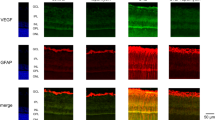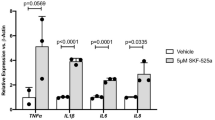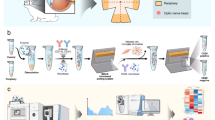Abstract
Purpose
Müller cells have important roles in the pathogenesis of diabetic retinopathy by promoting cell proliferation and inducing the production of vascular endothelial growth factor (VEGF) under hyperglycemic conditions. The objective of this study was to determine the potential mechanism of Müller cell proliferation and VEGF production due to high-glucose conditions.
Methods
Primary cultured rat Müller cells were incubated with medium containing variable concentrations of glucose and/or embelin, a specific inhibitor of X-linked inhibitor of apoptosis protein (XIAP), for 72 h. The proliferation of Müller cells was assessed by the MTT assay. The expression and/or phosphorylation of 146 proteins were assessed using protein pathway array.
Results
High concentrations of glucose-induced Müller cell proliferation and altered expression and/or phosphorylation of 47 proteins that have been identified to have key roles in several important signaling pathways (XIAP, VEGF, HIF1α, NFκB, etc) and are involved in the regulation of cell survival, proliferation, or apoptosis. However, Müller cell alterations induced by high-glucose conditions were counteracted by the XIAP inhibitor embelin, and 26 proteins/phosphorylations (out of 47) were restored to their normal levels. Nine proteins, including NFκB p65, p-p38, tumor necrosis factor-α, urokinase-type plasminogen activator, CREB, IL-1β, HCAM, estrogen receptor-α, and p-Stat3, were involved in regulatory networks between XIAP and VEGF.
Conclusions
The current study suggests that XIAP may be a potential regulator that can mediate a series of pathological changes induced by high-glucose conditions in Müller cells. Therefore, embelin could be a potential agent for the prevention and treatment of diabetic retinopathy.
Similar content being viewed by others
Log in or create a free account to read this content
Gain free access to this article, as well as selected content from this journal and more on nature.com
or
References
Shah CP, Chen C . Review of therapeutic advances in diabetic retinopathy. Ther Adv Endocrinol Metab 2011; 2 (1): 39–53.
Miller JW, Le Couter J, Strauss EC, Ferrara N . Vascular endothelial growth factor a in intraocular vascular disease. Ophthalmology 2013; 120 (1): 106–114.
Gupta N, Mansoor S, Sharma A, Sapkal A, Sheth J, Falatoonzadeh P et al. Diabetic retinopathy and VEGF. Open Ophthalmol J 2013; 7: 4–10.
Kieran MW, Kalluri R, Cho YJ . The VEGF pathway in cancer and disease: responses, resistance, and the path forward. Cold Spring Harb Perspect Med 2012; 2 (12): a006593.
Andreoli CM, Miller JW . Anti-vascular endothelial growth factor therapy for ocular neovascular disease. Curr Opin Ophthalmol 2007; 18 (6): 502–508.
Reichenbach A, Bringmann A . New functions of Müller cells. Glia 2013; 61 (5): 651–678.
Bringmann A, Wiedemann P . Müller glial cells in retinal disease. Ophthalmologica 2012; 227 (1): 1–19.
Nelson CM, Hyde DR . Müller glia as a source of neuronal progenitor cells to regenerate the damaged zebrafish retina. Adv Exp Med Biol 2012; 723: 425–430.
Hu LM, Luo Y, Zhang J, Lei X, Shen J, Wu Y et al. EPO reduces reactive gliosis and stimulates neurotrophin expression in Muller cells. Front Biosci (Elite Ed) 2011; 3: 1541–1555.
Ulbricht E, Pannicke T, Uhlmann S, Wiedemann P, Reichenbach A, Francke M . Activation of retinal microglial cells is not associated with Müller cell reactivity in vitrectomized rabbit eyes. Acta Ophthalmol 2013; 91 (1): e48–e55.
Brooks SE, Gu X, Kaufmann PM, Marcus DM, Caldwell RB . Modulation of VEGF production by pH and glucose in retinal müller cells. Curr Eye Res 1998; 17 (9): 875–882.
Bai Y, Ma JX, Guo J, Wang J, Zhu M, Chen Y et al. Müller cell-derived VEGF is a significant contributor to retinal neovascularization. J Pathol 2009; 219 (4): 446–454.
Hicks D, Courtois Y . The growth and behaviour of rat retinal müller cells in vitro. 1. An improved method for isolation and culture. Exp Eye Res 1990; 51 (2): 119–129.
Ye F, Che Y, McMillen E, Gorski J, Brodman D, Saw D et al. The effect of scutellaria baicalensis on the signaling network in hepatocellular carcinoma cells. Nutr Cancer 2009; 61 (4): 530–537.
Zhang DY, Ye F, Gao L, Liu X, Zhao X, Che Y et al. Proteomics, pathway array and signaling network-based medicine in cancer. Cell Div 2009; 4: 20.
Rungger-Brandle E, Dosso AA, Leuenberger PM . Glial reactivity, an early feature of diabetic retinopathy. Invest Ophthalmol Vis Sci 2000; 41 (7): 1971–1980.
Nikolovska-Coleska Z, Xu L, Hu Z, Tomita Y, Li P, Roller PP et al. Discovery of embelin as a cell-permeable, small-molecular weight inhibitor of XIAP through structure-based computational screening of a traditional herbal medicine three-dimensional structure database. J Med Chem 2004; 47 (10): 2430–2440.
Bhisitkul RB . Vascular endothelial growth factor biology: clinical implications for ocular treatments. Br J Ophthalmol 2006; 90 (12): 1542–1547.
Young TA, Wang H, Munk S, Hammoudi DS, Young DS, Mandelcorn MS et al. Vascular endothelial growth factor expression and secretion by retinal pigment epithelial cells in high glucose and hypoxia is protein kinase C-dependent. Exp Eye Res 2005; 80 (5): 651–662.
Wu Y, Zuo Y, Chakrabarti R, Feng B, Chen S, Chakrabarti S . ERK5 contributes to VEGF alteration in diabetic retinopathy. J Ophthalmol 2010; 2010: 465824.
Gyrd-Hansen M, Meier P . IAPs: from caspase inhibitors to modulators of NF-kappaB, inflammation and cancer. Nat Rev Cancer 2010; 10 (8): 561–574.
Wang W, Abbruzzese JL, Evans DB, Chiao PJ . Overexpression of urokinase-type plasminogen activator in pancreatic adenocarcinoma is regulated by constitutively activated RelA. Oncogene 1999; 18 (32): 4554–4563.
Wang J, Wang X, Hussain S, Zheng Y, Sanjabi S, Ouaaz F et al. Distinct roles of different NF-kappa B subunits in regulating inflammatory and T cell stimulatory gene expression in dendritic cells. J Immunol 2007; 178 (11): 6777–6788.
Baldari CT, Tonello F, Paccani SR, Montecucco C . Anthrax toxins: A paradigm of bacterial immune suppression. Trends Immunol 2006; 27 (9): 434–440.
Gaither A, Porter D, Yao Y, Borawski J, Yang G, Donovan J et al. A smac mimetic rescue screen reveals roles for inhibitor of apoptosis proteins in tumor necrosis factor-alpha signaling. Cancer Res 2007; 67 (24): 11493–11498.
Ameglio F, D'Auria L, Cordiali-Fei P, Mussi A, Valenzano L, D'Agosto G et al. Bullous pemphigoid and pemphigus vulgaris: correlated behaviour of serum VEGF, sE-selectin and TNF-alpha levels. J Biol Regul Homeost Agents 1997; 11 (4): 148–153.
Lemberger T, Parkitna JR, Chai M, Schütz G, Engblom D . CREB has a context-dependent role in activity-regulated transcription and maintains neuronal cholesterol homeostasis. FASEB J 2008; 22 (8): 2872–2879.
Plouët J, Moro F, Bertagnolli S, Coldeboeuf N, Mazarguil H, Clamens S et al. Extracellular cleavage of the vascular endothelial growth factor 189-amino acid form by urokinase is required for its mitogenic effect. J Biol Chem 1997; 272 (20): 13390–13396.
Tran J, Rak J, Sheehan C, Saibil SD, LaCasse E, Korneluk RG et al. Marked induction of the IAP family antiapoptotic proteins survivin and XIAP by VEGF in vascular endothelial cells. Biochem Biophys Res Commun 1999; 264 (3): 781–788.
Chitra M, Sukumar E, Suja V, Devi CS . Antitumor, anti-inflammatory and analgesic property of embelin, a plant product. Chemotherapy 1994; 40 (2): 109–113.
Mahendran S, Badami S, Maithili V . Evaluation of antidiabetic effect of embelin from embelia ribes in alloxan induced diabetes in rats. Biomed Pharmacother 2011; 1 (1): 25–31.
Acknowledgements
This study was partially supported by a grant from the National Science Foundation (No. 81070736) to E Song. The authors are grateful for Drs Jianhua Liu and Boxun Xie for their kind technical support.
Author contributions
DZ, ES, and FY contributed equally to this work by conceiving the hypothesis and overall study design. YS, DZ, and FY contributed equally to the experimental design, and DW and YS contributed equally by performing the protein pathway array assay. YS, XL, and LZ contributed equally to cell preparation. LG and YS contributed equally to the protein preparation. YS, DW and FY contributed equally to statistical analysis, and YS and DW contributed equally to summarizing the final data. YS and DZ contributed equally in preparing the manuscript.
Author information
Authors and Affiliations
Corresponding authors
Ethics declarations
Competing interests
The authors declare no conflict of interest.
Rights and permissions
About this article
Cite this article
Sun, Y., Wang, D., Ye, F. et al. Elevated cell proliferation and VEGF production by high-glucose conditions in Müller cells involve XIAP. Eye 27, 1299–1307 (2013). https://doi.org/10.1038/eye.2013.158
Received:
Accepted:
Published:
Issue date:
DOI: https://doi.org/10.1038/eye.2013.158



